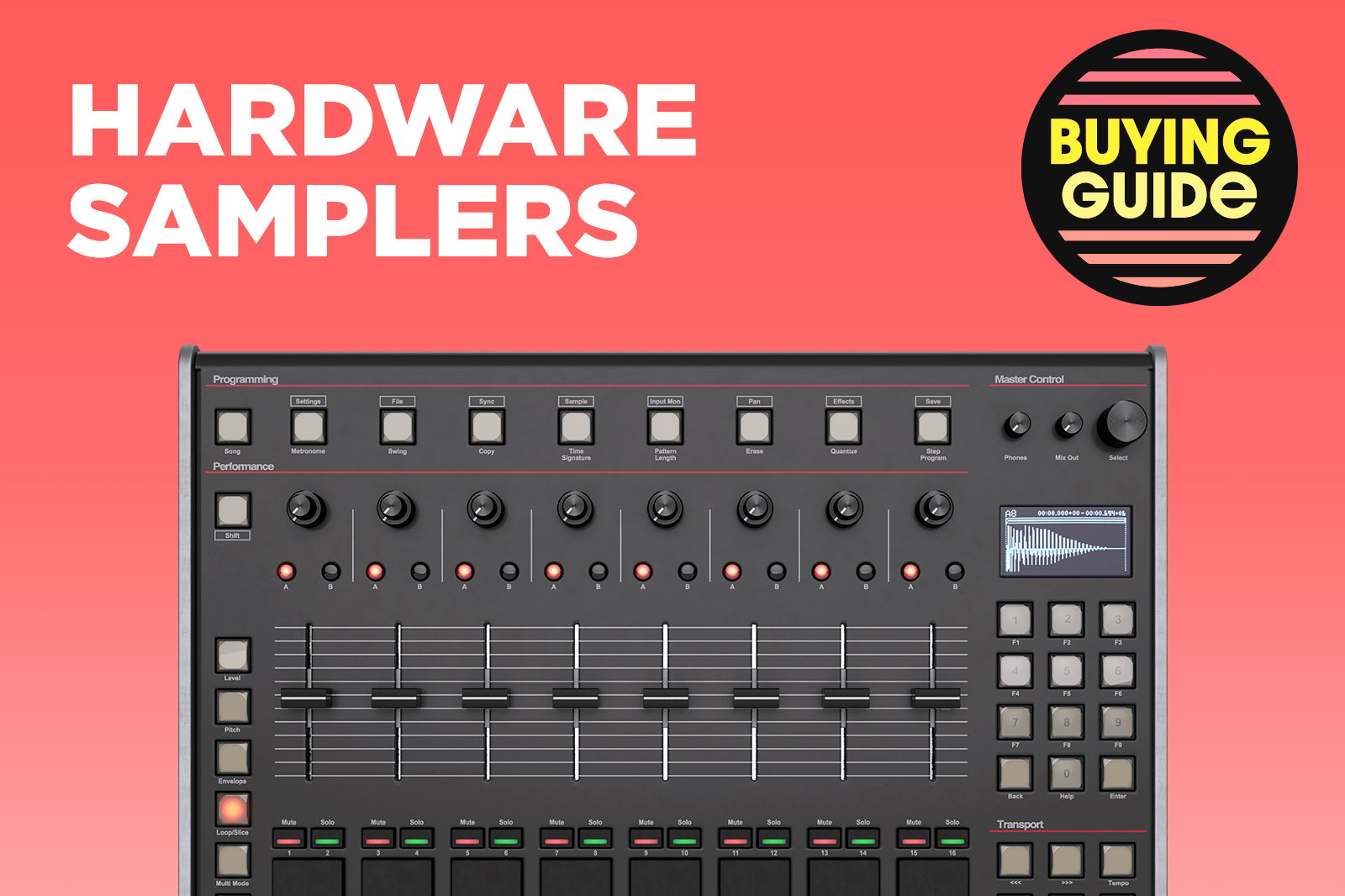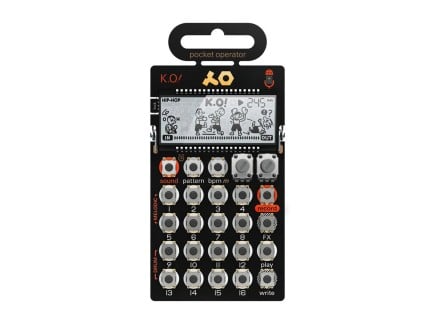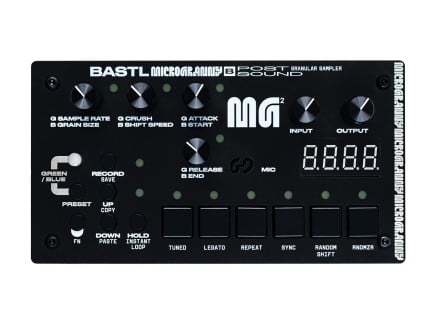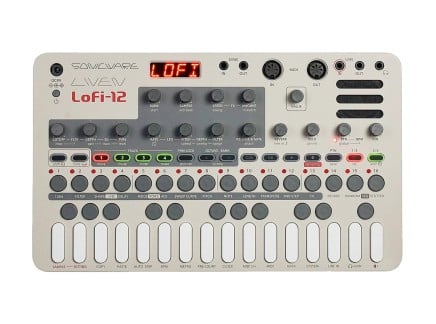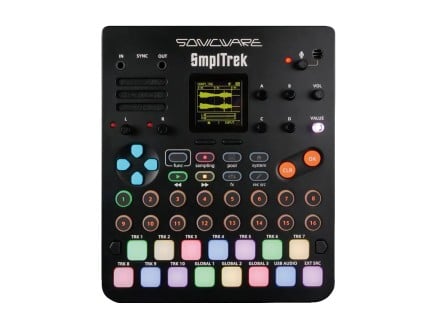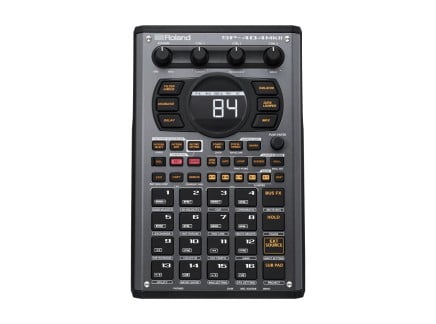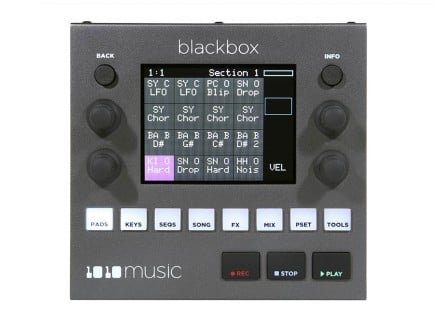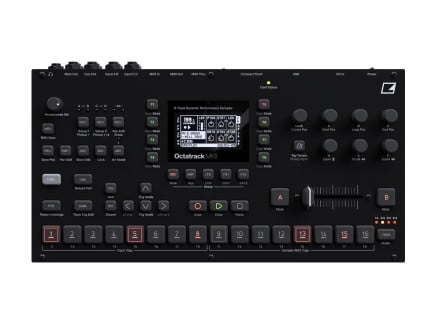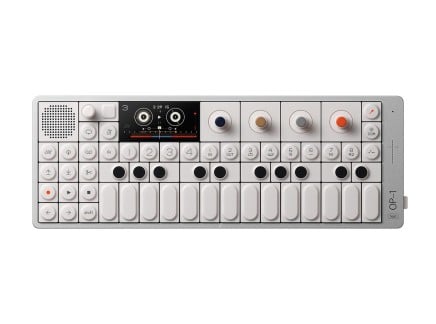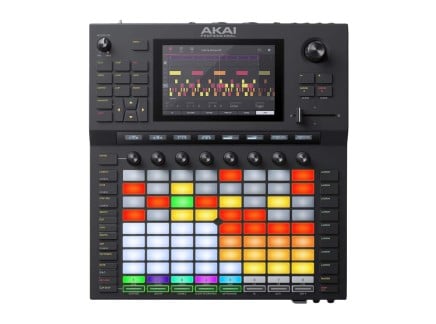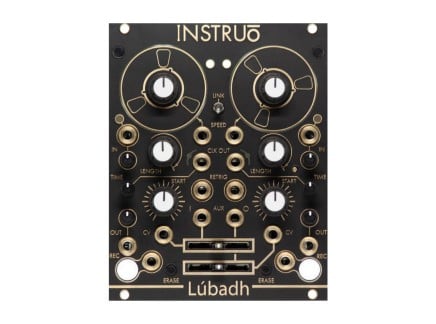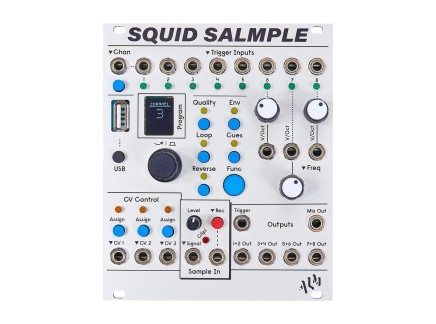Sampling has long since become firmly established as an integral part of modern music production. However, it wasn’t all that long ago where if you wanted to dabble with the dark arts, you had to contend with bulky rack units, floppy disks, and mere seconds of recording time (if you were lucky).
Nowadays we are spoiled for choice when it comes to the selection of devices that can record, mangle, and arrange sounds in a multitude of ways. From the small and straightforward to the large and sophisticated, there are a number of options available at every price point. Let’s dive in and take a look at some of the possibilities that are out there.
Hardware Samplers Under $500
If you're looking for a budget-friendly sampler, you've come to the right place. Here, we're taking a look at an astonishingly powerful selection of samplers which, at the time of publishing this article, are all available for under $500.
Teenage Engineering Pocket Operator PO-33 K.O.
Don’t let the size or low cost of the PO-33 fool you—it is a deceivingly capable micro-sampler with a rather impressive 40 seconds of recording time. You are able to capture the world around you via the onboard microphone, or pipe in external sources via the minijack input. The sounds can then be arranged into patterns via the 16-step sequencer, which includes per-step performance FX, and there is also the ability to chain sections together for longer compositions.
Phew. Not bad for such a tiny device. If you are looking for an immediate and fun way to get into sampling at an affordable price, then this may just be what you’re after.
Bastl MicroGranny Monolith
Bastl are a company that are well known for their mini-but-mighty devices, with a particular focus on noise and experimentation. The MicroGranny Monolith is the latest iteration of their celebrated MicroGranny—a crunchy monophonic sampler which comes in a portable package.
Samples are recorded in 8-bit for lofi goodness, but 16-bit wav playback is also supported. Up to 60 presets can be stored on a microSD card, with 6 sounds available per preset—and these can be played back via the dedicated keys on top of the unit itself, or alternatively, by hooking up an external MIDI controller (full-sized, 5 pin DIN connections!). The real power of the MicroGranny though, lies in its granular synthesis engine, which lets you warp and twist the samples to your heart’s content. This is one for the sonic explorers out there.
Korg Volca Sample 2
Korg’s Volca range has been wildly popular for providing capable and affordable electronic instruments in a compact package—and none was more anticipated than the original Volca Sample. This was an intuitive and hands-on sample arranger, with basic controls over the pitch, length, and other parameters—as well as a 16 step sequencer that has swing and groove.
With this second iteration, Korg have added USB connectivity to let you transfer samples more easily, and doubled the amount of memory available. If you are just starting out with electronic music, or if your main interest is in creating rhythmic patterns out of pre-prepared samples—perhaps in a small DAWless setup—then the Volca 2 could be a good shout.
Elektron Model:Samples
Sometimes, you just want to dive in and start making music, and not have to worry about complex workflows or convoluted setups. This is where this six-track groovebox from Elektron shines: Model:Samples is a no-nonsense workhorse that streamlines the Elektron workflow, leaving the core elements you need for powerful, sample-based sequencing.
Packed with hundreds of preset sounds to get you up and running straight away, you can also transfer your own samples over USB. The main focus of Model:Samples though is in its immediacy, and it couldn’t be quicker to put together unique patterns with the built-in sequencer, 6 velocity sensitive pads, and dedicated knobs for quick access to each function. Despite all of this, Model:Samples also has some surprising depth, thanks to the implementation of Elektron’s approach to ‘parameter locks’, for per-step sonic variations. This is a quick and fun way to kick off your music making process.
Affordable Sampling Options from Sonicware
If you are the type of free spirit that hates being tied to a studio when making music, the Sonicware SmplTrek could provide an alternative. With its built in microphone, jack inputs, and straightforward approach to recording, SmplTrek provides the means to quickly grab audio and put together tracks on the go from a variety of sources. You can load in samples via SD card, and make use of the built-in sequencer and extensive list of digital effects to structure your songs.This is a portable groovebox that has been specifically designed for those with a love for sampling.
One of the defining characteristics of early hardware samplers was their gritty 12-bit sample rate. In the modern era of high quality recordings, people are increasingly interested in replicating this, to bring a bit of edge and character to their music. The Liven Lofi-12 is a compact, battery-powered groovebox that takes this philosophy to heart—offering 128 slots that are capable of up to 4 seconds of sample time in 12-bit. There is a 64 step sequencer, and it even has a ‘lazy’ knob included, to help dial in that off-beat sound which has become associated with the LoFi hip-hop community. All in all, it packs in a significant amount of features for the price. If your primary interest lies in making chilled out beats to study to, then the Lofi-12 will be right up your street.
Hardware Samplers Between $500 and $1000
Of course, stepping into a slightly higher price range means you can expect some improvements—in terms of sound quality, build quality, and sampling capabilities in general. Here are some of the best samplers available in a slightly higher price range, between $500 and $1000.
Akai MPC One+
You’d be hard pressed to find a more legendary series of samplers than Akai’s MPCs. Their history is inextricably linked to the development of hip-hop and beat making culture, and to this day they remain incredibly well-respected for their particular approach to sampling, chopping, and soulful arrangement.
The MPC One+ is an ideal entry to this world, retaining as it does the spirit of its predecessors such as the MPC 2000XL, while simultaneously bringing the whole process bang up to date with modern conveniences for the digital age. The classic layout of 16 velocity and pressure sensitive pads are now accented by RGB LEDs; there is a touch screen to allow for ultra-quick and precise sample editing; and there are even built-in synthesis engines for when you want something a bit different.
You can sample into the MPC One+ directly via a pair of jack inputs on its rear, or make use of its expandable memory to load in WAV files. There is 2GB internal storage space by default, though you can increase this exponentially by installing an optional SD card—providing you more room for vinyl flips than the MPC users of yester-year could ever have dreamed of. Priced incredibly competitively, the MPC One+ is a pretty tough option to beat when it comes to sheer bang for your buck. It even includes assignable CV/Gate outputs for all you modular synth users out there.
The new MPC One+ maintains the features of the original MPC One, but add wireless connectivity and expanded internal storage—as well as a sharp red enclosure, all astonishingly at a considerably lower price.
Polyend Tracker + Tracker Mini
If you find yourself bored by the traditional horizontal approach to arranging music, then perhaps the Polyend Tracker could be for you. Inspired by the verticality that was popularized by software such as ProTracker and OctaMED for the Amiga, Polyend have brought this idiosyncratic workflow into the physical world with a dedicated piece of hardware. You can sample directly into the unit via the monophonic mic or line inputs on the rear, or by adding WAV files on microSD—and there is even a built-in FM radio to let you grab snippets from the airwaves.
The real star of the show though is the extensive way that you can creatively manipulate, sequence, and add effects to your collections of sounds, with 8 tracks, 128-step patterns, and dual, per-step FX lanes. This whole process may seem complicated at first, but it is both quick and intuitive once you learn some basics thanks to the large display, jog-wheel, and collection of 48 LED pads. Before you know it, you’ll be firmly converted to the tracker philosophy.
If you prefer making music on the go, then you might want to consider the Tracker Mini, which was announced as part of NAMM 2023. Built on the foundations of the original Tracker, the Mini squeezes its features down into a portable, handheld device with built-in battery. The FM radio of the OG has been removed, but the Mini boasts additional features, including improved processing power, stereo sample support, and support for audio over USB.
Polyend Play
Even if trackers aren’t your bag, Polyend may still provide an answer, in the form of its 16-track groovebox Play.
Strictly speaking, Play isn’t really a "sampler," in the sense that there is no way to record samples directly via a mic or line input. However, you can load in large banks of sounds from microSD, and the focus of this device is very much on creative sequencing and composition, thanks to its eight sample tracks, and a further eight polyphonic MIDI tracks to let you control external gear.
Getting started couldn’t be easier, thanks to the variety of options to create and randomize patterns and parameters. When you combine this with the clever use of "variations," and the multitude of FX that can be triggered via the dedicated performance mode, you have an incredibly accessible way of quickly producing and enjoying different kinds of music. Play is an ideal device for people who are more interested in making tunes from existing sample packs, rather than collecting or recording new ones.
Elektron Digitakt
If you are primarily interested in the creation of interesting rhythmic patterns, then you may wish to consider the Elektron Digitakt. Styled as a digital drum computer and sampler, this sleek metal box with delightfully clacky keys is packed with features to spice up your sequences, including Elektron’s unique approach to pattern locks. This allows you to adjust a variety of different parameters on a per-step basis—including the probability of a particular sound triggering, as well as manipulating different elements of the built-in FX, such as reverb and delay. All of this comes together to ensure that you never have to feel stuck in a basic four-to-the-floor rut ever again (unless of course, that’s what you want).
Recording samples into the Digitakt is incredibly easy—via jack inputs on the rear—and there is space for up to 33 seconds per sample. Alternatively, you can make use of its 1GB of internal storage, which also supports the transfer of WAV files from a computer. There are eight tracks available for you to arrange your patterns, and a further eight tracks to allow simultaneous control over external MIDI devices. While the Digitakt’s primary strength may lie in the percussive world, that doesn’t mean that it’s limited to drums—and there are plenty of ways to create full songs with a bit of creativity.
Roland SP-404 MkII
The Roland SP series has amassed something of a cult following, particularly amongst the lofi, beat-making crowd—and it’s easy enough to see why. Sampling is quick and easy, and the 17 chunky, velocity sensitive pads allow for a fluid and natural way to play your sounds back in real-time. On top of that, the built-in FX are incredibly musical, lending themselves just as nicely to studio work as live performance. This is very much a hands-on instrument, and one that begs to be tapped, tweaked, and adjusted on the fly.
The latest incarnation of the SP-404—the SP-404 MkII—has been highly anticipated, and brings with it a dizzying array of new features, including unique FX, 32-voice polyphony, an improved workflow for chopping samples more precisely, and a crisp OLED display. The most powerful SP yet.
1010 Music Blackbox
1010's Blackbox is a high-quality digital sampler that provides a range of slicing and playback options in a compact form factor. Its responsive touch-screen provides a familiar and natural way of working for those who’ve grown up in the digital era, though you can always hook up an external MIDI controller (via USB or minijack) for additional tactility if you prefer.
There are 16 sample slots available per preset that can be used for loops or one shots, as well as a host of different effects and sequencing possibilities.This is an all-in-one sampling studio that can hold hours of audio, and could be the ideal partner for live performers.
Going Pro: Samplers $1000+
Sometimes price is no object—you simply need the best, most flexible options for wrangling and mangling external audio. We can't blame you...so, here are some of the most interesting flagship sampling devices available today.
Elektron Octatrack
When it comes to twisting and mangling samples on the fly, Octatrack is King. Its idiosyncratic workflow can be tricky to get your head around at first, but once you are accustomed to its quirks, nothing comes close in terms of raw power for creative manipulation.
Realtime pitch shifting, time stretching, and looping are all possible (nay, actively encouraged), and spread across eight stereo tracks—with an additional eight MIDI tracks to control external gear. Storage is by way of Compact Flash card, and you can sample directly in via the four jack inputs on the rear.
One of the most interesting parts of the Octatrack is its cross-fader, which allows you to morph between two different predetermined scenes, either gradually or abruptly. If you are looking for a deep, capable sampler with a focus on live performance, and aren’t afraid of putting a bit of time in to understand a new workflow, then the Octatrack should be top of your list.
Teenage Engineering OP-1 Field
The original OP-1 is a design classic, and provided a unique, all-in-one sampling and music creation experience, thanks to its beautiful hardware, four-track tape-based workflow, quirky FX, synthesis, and sampling capabilities. The OP-1 Field builds on this legacy, and takes things to an entirely different level. Every part of the device has been upgraded or refined in some way, including an improved display, casing, and battery life which now extends to an almost unbelievable 24 hours. In addition to the classic sound engines, there is a new analog style synth called "Dimension," and "Mother" reverb.
The list of features and possibilities of the OP-1 Field is tough to do justice to in an article like this (an article like this one, though, is another story). Ultimately what people love about this particular sampling device is that it provides a complete and inspiring workstation for you to create full tracks in a stylish, and portable package. For some, it’s quite possible that this could be the one bit of gear you ever need to purchase.
Isla S2400
The S2400 is a modern recreation of one of the most legendary samplers of all time—the E-mu SP-1200. This is a chunky but beautiful desktop unit with a raft of connectivity that includes full sized DIN MIDI, RCA I/O, and 8 individual outputs, to let you process your individual sounds separately through outboard gear (e.g. whacking a saturator on the kick, filter on the hi hats, etc).
Samples can be recorded on the fly, or imported from SD card, and there is even a USB audio interface built in. The real magic of the S2400 though is in its old school workflow, and particular sonic signature—both elements which have been faithfully replicated here. To that end, you can choose between the classic crunchy 12-bit sample rate, or the cleaner 24-bit alternative. This is a special machine for those that are serious about their beat making and sample based creations.
Akai Force
The phrase "DAW in a box" gets thrown around a lot, but it’s probably never been more accurately applied to a device than the Akai Force. This particular device is an incredibly powerful music production workstation, which can be operated either standalone, or in conjunction with a DAW such as Ableton. It combines the sampling might of the MPC series with a clip-based approach to performance and arrangement, making clever use of its 64 velocity and pressure sensitive RGB pads.
There are a vast array of synthesis engines, FX, sequencers, and other features included. Force has 16GB of built-in storage, but also supports the use of SD cards and the installation of an additional SSD hard drive, providing more space for sampling and track creation than you would be able to fill in a lifetime. It is a truly impressive bit of equipment.
But What About Eurorack?
The range of modern hardware samplers aren’t limited to standalone desktop units, of course.
If you’ve already fallen down the modular rabbit hole, then you might want to check out the Squid Salmple from ALM Busy Circuits. This 21hp module has eight channels that can be used for both the recording and playback of mono samples—a maximum of 11 seconds per channel—which are stored on a handy USB thumb drive that connects at the front. There are individual trigger inputs, and—as you would expect from Eurorack—a number of different modulation possibilities, including CV inputs with assignable destinations, and 1V/Oct control over channels 6–8. This is the perfect way to integrate the magic of sampling into your rack.
One notable mention has to go to Lúbadh—a unique and creative Eurorack module from Scottish builder Instruo. Coming in at 20hp of rack space, this striking creation provides digital recreations of two looping tapes, which provide an extensive amount of sampling time, but also endless creative possibilities, thanks to the variety of ways that you can manipulate the recorded sounds. Pitch shifting, looping, octave delays, broken tape emulation and saturation are all possible, with extensive CV control. This approach to sampling helps provide a different perspective on how to use captured audio, and is perfect for the creation of cinematic textures and soundscapes. A module for those that are interested in sonic experimentation.
All that said, this article isn't the right place to go deep into a discussion on modular sampling—that's a whole deep topic all its own. Who knows, though...perhaps you'll see a Eurorack sampling-oriented buying guide in the not-too-distant future...

